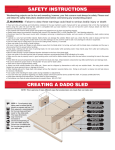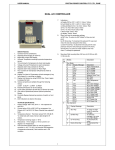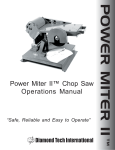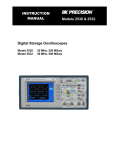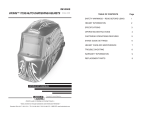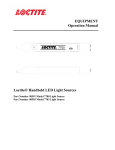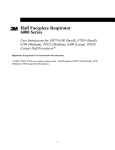Download Constructing The Box Joint Jig
Transcript
US Patent Pending WARNING Failure to obey these warnings could lead to serious bodily injury or death. • Always wear eye protection complying with cur1 Constructing The Box Joint Jig a) The SBOX8 Box Joint Cutter Set should be used with a box joint jig for best results. A simple, effective box joint jig can be made using these instructions. Plans and instructions are also available from commercial sources and magazines and commercially produced jigs are available. c) Next cut a piece of 3/4" plywood to 24" X 6". Turn the saw off, disconnect the power to the machine and stand this piece on the long edge with one face against the miter gauge of the saw. Set the table saw fence to 12". Place the two hardwood pieces from step b side by side against the fence and butt the plywood to them so that there is a space b) A separate jig must be constructed for each pin size. Disconnect the power to the the two hardwood pieces and slide the plywood over to the fence. Clamp the plywood to the miter gauge and mark the location of the holes in the miter gauge that will be used to mount the plywood. Remove the plywood and drill and counter bore the mounting holes. Attach the plywood to the miter gauge, ensuring that the heads of the mounting bolts do not extend beyond the face of the plywood. Next, move the saw fence at least 1" away from the jig for safety clearance. between the fence and the plywood that is equal to twice the pin width. d) Set the cutter height to the same as the cutter width (d-1). Reconnect the power to the machine and turn on the saw. Use the miter gauge to slide the plywood over the cutter to make a slot. Turn the saw off and slide the jig back to the starting position (d-2). (d-1) Set The Cutter Height 1/4" Remove The Hardwood Keys 3/8" or 3/8" 1/4" SAW TABLE TOP (e) SAMPLE WOOD TO BE CUT SAMPLE WOOD TO BE CUT SAW TABLE TOP Slide To Fence CUTTER SBOX8 Box Joint Instructions Thank you for choosing the Freud SBOX8 Box Joint Cutter Set. These premium quality, patent pending cutters are easy to use and will produce consistently flawless box joints in all wood and wood products. The instructions that follow will guide you through building a simple jig to use with your table saw’s miter gauge and completing finished joints. Be sure to read and understand all warnings and instructions before using these cutters. machine and set up the cutters for the desired pin width. Reconnect power to the machine, turn the saw on and make a sample cut in scrap stock. Next machine a strip of hardwood to the same width and height as the sample cut and at least 5" long. Check the fit of the strip in the sample slot. When properly sized the strip will fit snugly but will not require force. Cut the strip into two pieces 2-1/2" long. One of these will be used as the reference key and should be lightly chamfered on the edges. any contact between the throat plate and cutter. • Properly secure work piece before cutting. • Allow saw to reach full speed before cutting. • If you ever have any questions regarding your blade, please call Freud Customer Service at 800472-7307. In Canada call 800-263-7016. • Keep these warnings and instructions in a safe place for future reference. CUTTER rent CSA standard Z94.1 or ANSI Standard Z87.1. • Carbide is a very hard and brittle material. Slight shocks can damage the carbide. Before each use, check that the cutter is sharp and free from cracks, loose teeth, missing teeth, broken teeth or any other damage. Do not use if the cutter is dull or any damage is noticed or suspected. • Use the cutter only for cutting wood. Do not use for cutting metal, masonry, or concrete. • Keep body, clothing and hair clear of spinning blade. Do not wear jewelry while operating cutter. Keep hands away from cutter and cutting area. Never perform operations free hand. • Always use both blades. • Mount cutter securely in proper rotation direction indicated on the face of the blade itself. • Never use cutter in the saw machine that will exceed maximum recommended blade RPM indicated on the cutter. • Never use cutter in the vicinity of small children. • Read and obey all warnings and instructions contained in saw machine's user's manual and for any accessory that is from the manufacturer before using the cutter. Be sure that this cutter is compatible with your saw machine. If you do not have the user's manual, obtain one from the machine's manufacturer before using cutter. • Only operate saw machine when proper saw guards and protections are in place and working properly. • Always check clearance on throat plate before connecting power to the saw. Do not use if there is ® (d-2) Cut The Slot (c) (b) Scr Mill the key to fit the test cut Ha rd od wo Ke y 2-1 2 " -1/2 ap Sto ck f) Glue the key into the slot with the end flush with the back face of the plywood. Set Fence Stop To Cu (f) 12" t /2" 2 Hardwood Pins Side by Side 5" 2 Hardwood Pins Side by Side 2 Glue Hardwood Key Flush With The Back & Bottom Of The Plywood Jig. The Key Should Protrude The Front As Seen Here. e) Disconnect the power to the machine. Remove 3 cutter are not in contact with the other cutter. Set the cutter height 1/64" higher than the thickness of the material to be joined. Cutting the Joints A) Begin by determining the width of pin desired (A-1). Disconnect the power to the saw. For 1/4" pins the cutters should be mounted on the saw such that the printed sides are facing to the outside. For 3/8" pins the cutters should be mounted on the saw such that the printed sides are facing inward (A-2). Ensure that the arrows are indicating the appropriate direction for the saw and that the carbide tips of each 1/4" (A-1) A B) Start by making test cuts in sample pieces that are the same thickness and width as will be used for the finished joints. With the saw unplugged and switched in the off position stand 1 test piece on end and slide to butt up to the key. Clamp the piece securely to the jig. Reconnect power to the machine, turn the saw on and slide the jig across the cutters to produce a slot and one pin. 3/8" B B A piece on end and butt it up to first piece. Clamp the second piece securely to the jig and remove the first piece. Reconnect power to the machine, turn on the saw and slide the jig across the cutters to produce a notch. Both Notches Fit Over Key For Cuts Rotate A B A Caution: Be sure the handle & Body of the clamp will not hit the cutter as you slide the jig forward 1/4" C) Turn off the saw and disconnect power to the machine. Unclamp the first piece and flip it around so that the slot is over the key and the pin is toward the miter gauge. Stand the mating Graphics Facing The Inside To Cut Joint 3/8" 4 F) Turn off the saw, disconnect the power to the machine and unclamp the pieces. Check the fit of the joint. The two mating pieces should fit together easily but with slight friction. A loose fit and visible gaps indicate that the space between the cutters and the key is too narrow. An overly tight joint indicates that the space between the cutters and the key is too wide. Adjust the jig as necessary and proceed to cut the finished pieces. Glue Clamp (F) E) For subsequent cuts turn off the saw, disconnect power to the machine, unclamp the pieces, move both so that the slots just produced are over the key and apply clamps. Reconnect power to the machine, turn on the saw, and make another cut. Repeat (B) Graphics Facing The Outside To Cut Joint B A (C) Fit Over Key For Setup (G) Rotate 1" or more safety clearance (A-2) until all pins are completed. (D) D) Turn the saw off and Disconnect the power to the machine. Unclamp the second piece. Turn the first piece around so that it is in the original orientation and the slot is over the key. Put the second piece in front of the first with the notch over the key. Securely clamp both pieces to the jig. Reconnect power to the machine, turn the saw on and slide the jig across the cutters to produce a slot and a pin. A B Sand (E) A B G) Apply glue evenly to the inside surfaces of the pins on one piece of each joint. Assemble and clamp according to the directions for the adhesive. After the assembly has dried the ends of the pins can be sanded flush. 5 ® 6


